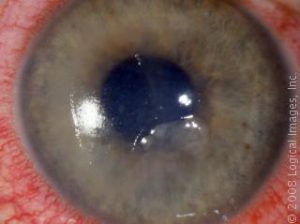 A corneal abrasion occurs when the outer layer of the cornea, called the epithelium, is torn away. (The cornea is the clear outer coating of the front of the eye.)This can occur by a variety of means such as a finger in the eye, a tree limb, flying glass in an automobile accident, etc. It is one of the most common injuries to the eye.
A corneal abrasion occurs when the outer layer of the cornea, called the epithelium, is torn away. (The cornea is the clear outer coating of the front of the eye.)This can occur by a variety of means such as a finger in the eye, a tree limb, flying glass in an automobile accident, etc. It is one of the most common injuries to the eye.
The corneal has more nerve endings than virtually any other part of the body. Because of these many nerve endings, any damage to the cornea is very painful. Abrasions usually heal in a short time period, sometimes within hours. But while they are healing they can cause excessive tearing, redness, blurred vision and light sensitivity. In many cases, the cornea will heal overnight during sleep. If treatment is needed, it consists of a tight patch to keep the lids from moving and pain relievers as needed for comfort.
An antibiotic may be used following an abrasion because the open area of the epithelium invites infection. Small abrasions heal rapidly. However, if one covers more than one-third of the cornea, it may take an extra day or two for the epithelium to completely recover the front of the cornea.
Typically, an anesthetic is used in the eye doctor’s office to ease the pain and to aid in the examination. After the examination, the pain typically returns. But, repeated use of anesthetic can harm the eye and is therefore not used in the treatment of abrasions. It may take several weeks for all the blurriness to resolve. Permanent loss of vision is very rare with superficial abrasions.
DO NOT rub the eyes during the healing phase following an abrasion. New cells require time to re-connect to the non-damaged layers of the cornea. These new cells can be easily rubbed off. If the new cells get removed, the pain returns and repatching is necessary.
Occasionally, long after an abrasion has healed it recurs spontaneously, often upon awakening in the morning. This is called a recurrent erosion and represents an area of the epithelium that is not re-connected well to the deeper parts of the cornea.
The treatment is similar to that for the abrasion. Sometimes the surface of the cornea is treated with a special instrument in order to help form better connections between the corneal layers. Extended use of bedtime ointments or lubricants may also help in preventing recurrent erosions.

